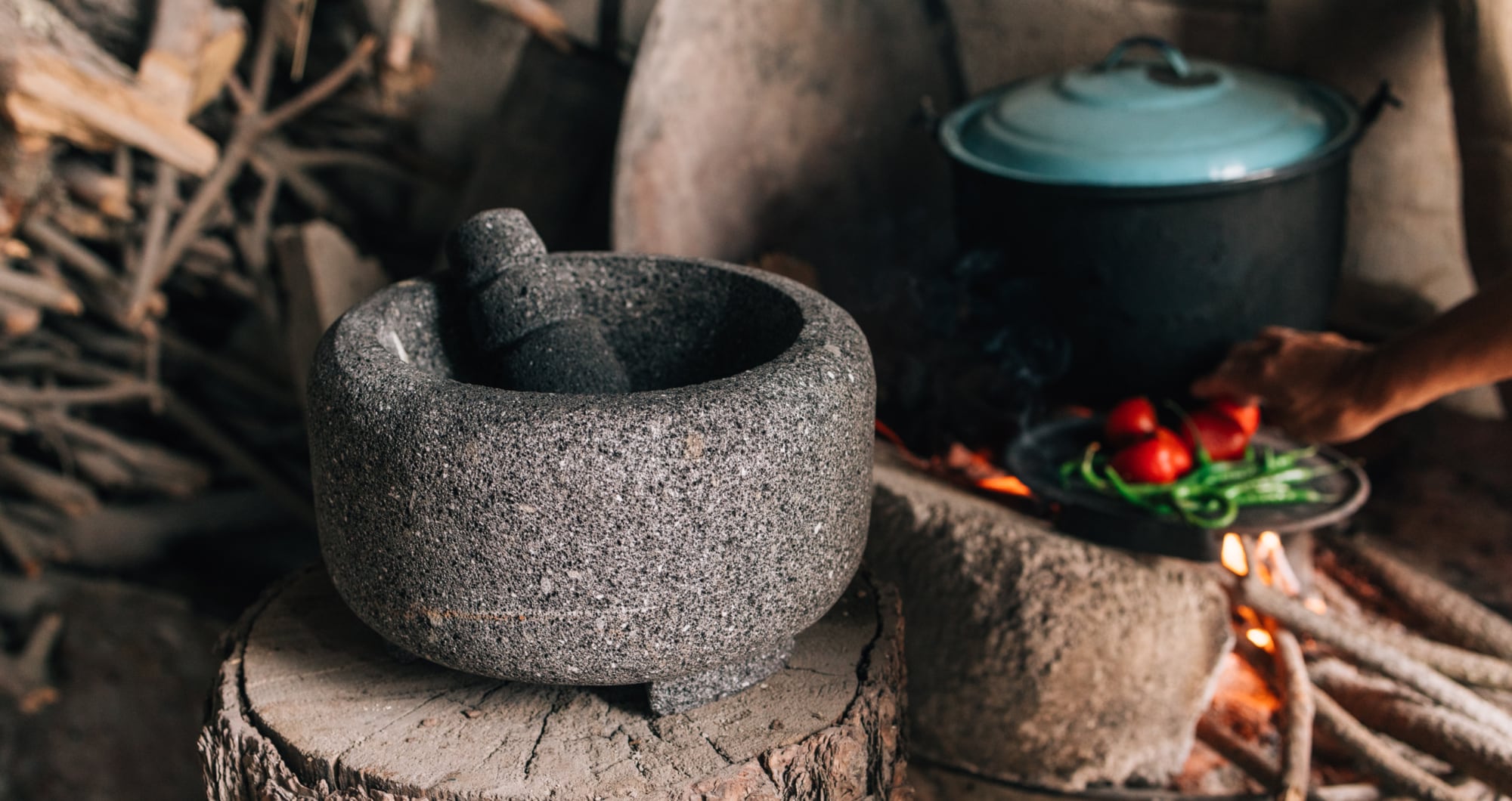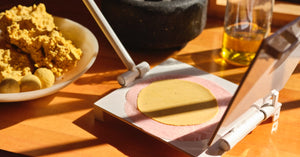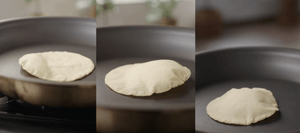Article by Andrea Aliseda
Photography by Mónica Godefroy
For the cook whose soul is flavored by the cosmos that is Mexican cuisine, a molcajete is essential technology to have in the kitchen. As the renaissance of Mexican gastronomy continues to unfurl, ancient methods of cooking are resurfacing and being closely embraced with eagerness in our modern kitchens, edging us closer to the cuisine’s Indigenous origins. Contemporary equipment like blenders have long had a hold on methods of preparation in making salsas or guacamoles, one of the main foods prepared with molcajetes, and they’ve made these dishes easier to whip up with the electrical push of a button. But it’s the old-school grind of Indigenous instruments that yield a richer flavor you won’t soon forget. The molcajete is perhaps one of the most accessible ancient and quintessential tools for 21st century cooks to own and hone, and carves a path to more deeply connect with staples of regional Mexican and Pre-Hispanic gastronomy.
The Molcajete: From the Core of The Earth to The Heart of Your Kitchen
The Molcajete: From the Core of The Earth to The Heart of Your Kitchen

June 23, 2022
Herbiberto García Rivas of the book, ‘Cocina Prehispaníca Mexicana’, dubs the molcajete as the second most important piece of the Indigenous Mexican cuisine, after the metate. Authors Bricia Lopez and Javier Cabral of the cookbook, 'Oaxaca: Home Cooking From the Heart of Mexico,' also exalt this cornerstone of the Mexican kitchen. “A salsa or guacamole made in a blender or food processor will never replace the velvety, chunky texture of a salsa made in a molcajete,” they write. “It is Mexico’s premiere Pre-Hispanic piece of cooking equipment that hasn’t changed for thousands of years.”
Because the truth is, once you make a salsa in a molcajete, you may never go back. The rub and crush of its gritty stone walls open up a breath of flavors from every ingredient — from nut, to seed, to chile and garlic — bursting open their fragrance and fusing together notes and characteristics with a harmony that sings.
Pictured: Yolanda Juárez Gutiérrez, Don Enrique's mother-in-law and local salsa whisperer.
On the History of the Molcajete
The molcajete, a Nahuatl word meaning “sauce dish” and known as “mortar and pestle” in English, is an Indigenous technology that was engineered in what is known as the Cenolítico Superior era, between 7000 BCE and 5000 BCE, roughly around eight thousand years ago. During this era people relied namely on foraging, and diets consisted largely on seeds and fruits. The molcajete is shaped round and concave, a bowl held up by three or four legs, that is made complete with the hand tool called tejolote — together they’ve been used to grind spices, seeds, chiles, nuts, herbs and more for millennia. Traditionally and historically, molcajetes are made with a porous volcanic stone, rich in minerals like iron and magnesium, and it gets pounded and carved carefully into the shape we are familiar with today.
Making Masienda's Molcajetes
We partnered with artisan Don Enrique of San Salvador El Seco, Puebla, on two contemporary Molcajete designs that'll not only help unlock layers of flavor in your favorite dishes, but also look great displayed on the kitchen counter, with their sleek, rounded look. Our original Molcajete is perfect for families or parties, while Molcajete Chico makes enough guacamole or salsa for two.
Artisans who work with stone are proud of their craft, and are called canteros. Canteros can create a plethora of works with stone, but at the heart of their craft is the knowledge of making a molcajete with precision. Don Enrique tells Masienda that shaping a molcajete is no easy feat, and can vary in shapes and designs while retaining the same core structure. Don Enrique, who comes from a lineage of canteros, has been making molcajetes since he was around 13 years old, and the over twenty years of experience have made him a master in his craft. It’s a fine art shaping a molcajete, there are a variety of tools one uses at each stage, and certain weight to be attributed to each. One wrong plunk, and the sculptured rock cracks.
When out mining for volcanic rocks to fashion into molcajetes, he uses his hand to measure, stretching from pointer finger to thumb, giving him approximately a measurement of around 8 to 9 inches. Two generations ago, his great grandfather may have relied on a donkey to travel with these blocks of volcanic rock, but these days Don Enrique, who works with a team of about five men, loads the blocks into his van where he transports them back to his workshop. There his small curly haired dog, Peluche (Spanish for teddy bear or stuffed toy), stands guard. “He’s small, but thinks he’s a mammoth,” Don Enrique says of Peluche.
The volcanic rock is scoured from the earth on the back of a volcano that is popular in Mexican folklore, el Popocatépetl. It takes a skilled cantero about three hours to compose one molcajete, but this particular molcajete is forever imbued with a mythical tale of two lovers.
The legend of Popocatépetl and Iztaccíhuatl is easily Puebla’s own Romeo and Juliet, and is a story thousands of years old. Popocatépetl and Iztaccíhuatl were enamored with one another; Popocatépetl was a lauded warrior, Iztaccíhuatl was a princess. War would rip them apart, but the lovers had a silver lining: If Popocatépetl returned from war with his life, he and the princess would be allowed to marry. So when Iztaccíhuatl got word that Popocatépetl had perished, she had no will to go on without him. The news turned out to have been fabricated by a jealous foe, and Popocatépetl returned home to a shattered heart. To honor her, he took her body to a mountain top, where they two lay together in each other’s arms for eternity. Over time, their embraced bodies became part of the landscape, to the volcano we know today. And it is said, when Popocatépetl remembers his lost love, the volcano trembles and fumes with grief.
How to Cure and Clean Your Molcajete
Once home with a new molcajete it is wise to cure it, Don Enrique says it’s because it’s still dusted by the earth and can have some loose grains of rock. Though some methods vary online, the most common, practical and effective way to do this is to add some spoonfuls of dry or raw grains of rice into your molcajete along with salt and grind until you have a powder. It’s common for the powder to look gray at first, this is the method at work, picking up the dust and pieces of rock being released. Remove the powder and grind new spoonfuls of rice and salt until they no longer have a gray hue and hold their white color. Be sure to grind with all the edges of the tejolote that you’ll use to triturate with. This will be the arm workout to end all arm workouts. Rinse well and scrub using a brush, try to use an escobeta de raíz, or root brush made with agave fibers, and reserve it only for scrubbing your molcajete for maintenance. If you can’t find one, a regular dish washing brush will do fine––just do not add soap while you cure. Don Enrique says soap is okay only after the initial curing, as to not leave the taste of soap caught in its porous texture. Some people, like Lopez and Cabral of ‘Oaxaca’, recommend another step in curing: adding a chile like jalapeño and a clove of garlic before the last rinse. Once you have given your molcajete its final rinse, let it air dry before you place it out on the counter in all its decorative glory. Between uses, scrub with your brush and use a soap if you’d like.
You may notice the colors of the molcajete vary slightly, this is due to the unique expression of each volcanic rock, ranging from darker to lighter shades of gray. Each molcajete exhibits an organic range of the many volcanoes that exist on Mexico’s terrain, their eruption rumbling from the core of the earth, that when shaped through expert hands lead cooks to the very heart of the land’s cuisine.



All Comments
Hi Lakshsrnni! We love Rick Bayless, and we know he loves our molcajetes, but we’re not sure which video you’re referring to. Here’s a link to both of our molcajetes in case you’re interested: https://masienda.com/products/molcajete
Can I get the same one RickBayless has in his Salsa video
Hi Angie! The molcajete chico doesn’t have legs — it sits flat on the counter.
Does the smaller 7-inch molcajete have feet like larger 9-inch one does?
Hi Dennis! Yes, they’re made exclusively in San Salvador El Seco, Puebla.